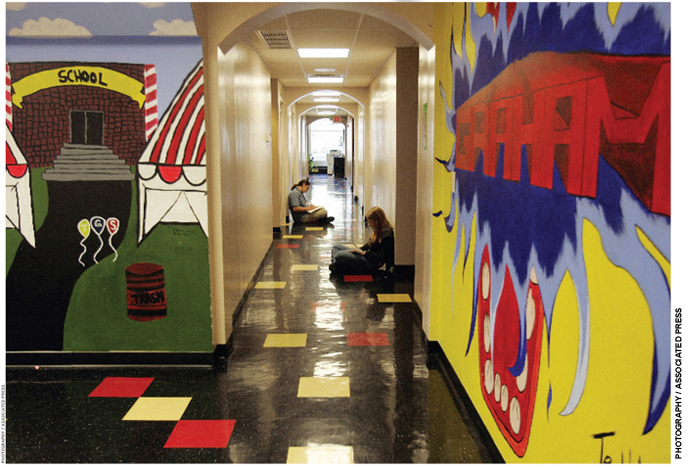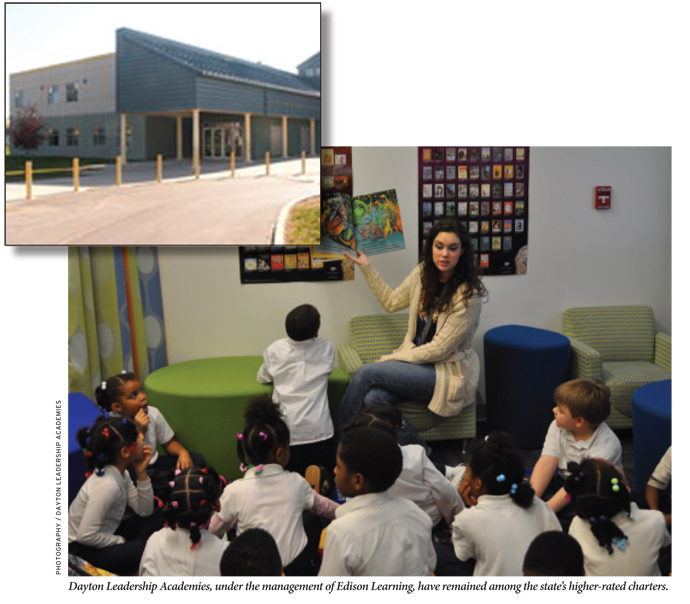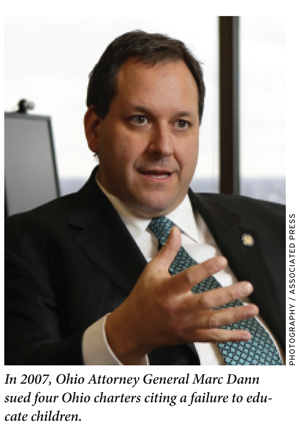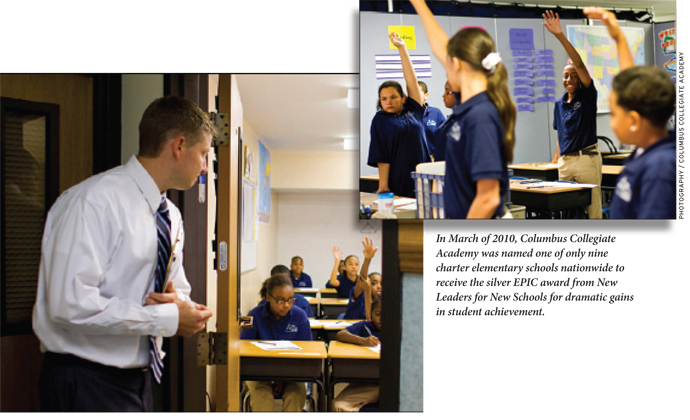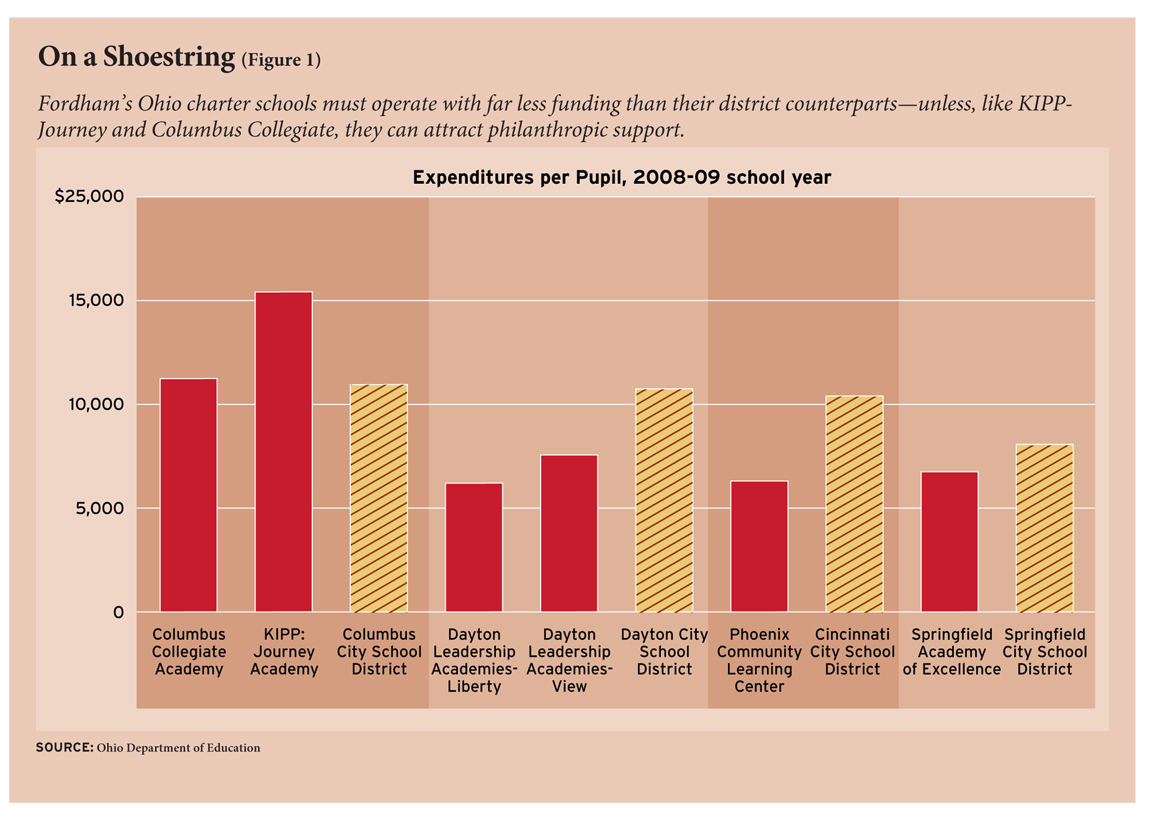Video: Chester Finn and Terry Ryan talk with Education Next.
Adapted from Chester E. Finn Jr., Terry Ryan, and Michael B. Lafferty, Ohio’s Education Reform Challenges: Lessons from the Front Lines, Palgrave McMillan Publishers (June 2010).
The Thomas B. Fordham Foundation’s long and deep immersion in Ohio education policy, particularly in the charter-school realm, includes a half decade of direct experience as “authorizer” of several charters. To recount and draw lessons from that experience, Fordham president (and Education Next senior editor) Chester Finn, Fordham vice president for Ohio policy and programs Terry Ryan, and veteran journalist Michael Lafferty authored the new book from which this article is adapted.
Initially, the Ohio Department of Education (ODE) was chief authorizer of charter schools in the Buckeye State. After the state auditor released a scathing review of ODE’s handling of its role, the legislature “fired” the agency and in early 2003 invited a host of other entities to undertake the challenges of school sponsorship. Along with state universities, and district and county school systems, the list of potential authorizers included nonprofit organizations that met certain criteria. If too few new authorizers were willing to step up to the plate, however, the legislature’s move would orphan more than 100 extant charter schools, forcing them to close.
The Thomas B. Fordham Foundation had long been active on the Ohio charter scene as critic, policy analyst, facilitator of new schools, and source of assistance (both financial and technical) to promising charter operators. But we had never really rolled up our sleeves and plunged into the fray. After fruitlessly seeking new sponsors to take on the potential “orphans”—eligible organizations feared the political, financial, and legal-liability risks—and after much internal soul-searching and debate, Fordham decided in 2004 to apply to become a school authorizer and by June 2005 we found ourselves occupying that hot seat.
Our 10 schools were a varied bunch. Eight had previously been sponsored by the Ohio Department of Education. The other two were allowed to open by virtue of winning the state’s 2005 lottery for new charters; both were sister schools of Cincinnati’s acclaimed W. E. B. Du Bois Academy, a now-defunct charter school that was much acclaimed at the time. All 10 schools faced challenges that generally paralleled those of other charter schools across Ohio. Among the eight schools with track records, one was rated Excellent by the state in 2005 (Du Bois), and one was rated Continuous Improvement (Dayton Academy, an Edison-operated school), but the remaining six were in Academic Emergency. (At the time, 60 percent of Ohio’s charter schools were rated in Academic Emergency, 11 percent in Academic Watch, 18 percent in Continuous Improvement, and just 11 percent Effective or Excellent.)
Troubled Schools
The Moraine Community School had struggled since opening in 2002, but surely it was worth trying to rehabilitate. The charter represented this Dayton suburb’s only public school. Moraine was a General Motors industrial town, and many of its families were connected to the GM plant that had once made Frigidaires and later built SUVs. (The last vehicle rolled off its assembly line on December 23, 2008. The sprawling factory is now dark.)
Before the charter opened, all Moraine students were bused to schools in the nearby suburbs of Kettering and West Carrollton. Many felt like strangers there, and they and their parents longed for a neighborhood school of their own. For that reason, the Moraine charter originally enjoyed the support of community leaders and served about 200 children in grades K–12. Almost from the start, however, the school encountered serious governance, leadership, financial, and academic difficulties. Moraine Community School was in Academic Emergency for two years prior to Fordham sponsorship, and its board and principal had gone through a nasty split just before we took over. A serious leadership vacuum remained. Our sponsorship agreement made clear that we expected it to improve markedly—and fast. Its board assented. According to our contract, the school would show
• adequate academic gains from autumn 2005 to spring 2006, as measured on a national norm-referenced test
• market demand by enrolling at least 225 students by April 2006
• compliance with all special-education requirements by October 2005
• implementation of a viable curriculum by February 2006.
As the February deadline approached, we received a letter from the school’s board president stating, “Our one-year sponsorship agreement had renewal terms that we likely won’t meet. There was an opportunity to secure 2006/2007 sponsorship through the Cincinnati-based ERCO (Education Resource Consultants of Ohio).”
With those words, Fordham learned, the Moraine school was fleeing our tough-love embrace. We had thought its leaders were game to make the hard decisions needed to render their school effective. We were wrong, and they spurned us for a less-demanding sponsor. What’s more, under Ohio law the school was within its legal rights to “sponsor hop” when its leaders realized we were serious about holding them to account for improving their school. Two years later, the Moraine school and three others (with no Fordham sponsorship connections) would be sued by then Ohio Attorney General Marc Dann, citing a failure to educate children.
In hindsight, we were naïve about the Moraine school and our ability to turn it around through tough love. No matter how much we wanted the school to succeed academically, those in charge—the school leadership and teachers—did not have the capacity to make it perform at a high level. Even more important, we gradually realized that the school’s leadership did not see their primary mission as delivering academic success to children.
For them, the goal was to provide a place that cared for the community’s children with love, respect, and understanding. If learning also occurred, well and good, but the school’s very existence was a sufficient end in itself for both the board and many parents. It was, quite simply, “their” school. Our efforts to inject a sense of urgency and focus on academic results just did not fly. That we didn’t share the same values should have been obvious from the start. But we failed to see it.
Moraine was not the only school in our new “portfolio” that opened our eyes to some realities of the charter world that we had not fully appreciated in our earlier think-tank role. As we were learning, threats and deadlines alone did not bring about better performance. Thus, within the bounds of state law and our budget, we also provided technical assistance to “our” sponsored schools to improve their performance. For example, we offered all those in Academic Emergency expert counsel on how to use achievement data to improve instruction, develop a strategy for maximizing performance on state assessments, and help students gain test-taking prowess.
Toward that end, we engaged Douglas Reeves and his team at the Denver-based Center for Performance Assessment (CPA). In November 2005, participating schools were provided with the tools to analyze their own test data to ascertain where their students needed the most help. In February 2006, CPA trainers conducted sessions at each participating school to assess staff needs and provide more-focused professional development based on school and student-specific data. This assistance cost Fordham about $70,000, but held out hope of helping the schools to boost student achievement relatively quickly.
We also offered the schools outside evaluations by a Massachusetts-based team of charter experts that provided school leaders and Fordham with thorough analyses of the strengths and weaknesses of individual schools and assisted in developing plans for bettering their performance. We asked team leader Joey Gustafson for a written report on each school akin to those produced by the acclaimed British school inspectorate. Four schools agreed to such evaluations—at Fordham’s expense.
After visiting the schools, Gustafson reported that all four—each an independent “mom-and-pop” operation with no links to national groups—faced a host of challenges, including strained budgets, low enrollments, curriculum problems, inexperienced staff, weak professional development for teachers, and board members ignorant of testing and other academic essentials. She also found a widespread belief that their academic setbacks were not the schools’ responsibility but, rather, the result of too many students from poor families with “home life” issues.
According to Gustafson, “These kids cannot” was the start of far too many conversations. She urged Fordham to take school leaders to visit high-performing charters in other states so they could see how such institutions worked. The result was a trip to Washington, D.C., where the heads of Fordham-sponsored schools spent time in a high-performing Knowledge Is Power Program (KIPP) school and the excellent charter boarding school called SEED Academy.
These repair efforts bore some fruit. The Phoenix Community Learning Center in Cincinnati, for example, made solid academic gains during 2004–5, when it was in Academic Emergency, to 2005–6, when it was rated Effective by the state. (The school sustained those gains in both 2006–7 and 2007–8, then faltered in 2008–9.) This school, led by a savvy, veteran educator, was committed to constant academic improvement and willing to change course in order to strengthen student results. It also built a strong instructional team and in time turned into a reasonably solid performer, a lamentably rare success within Ohio’s bumper crop of “mom-and-pop” schools.
It was evident, however, that some schools still needed far more help than we felt appropriate delivering as their sponsor, and more than we could afford financially. There was a real risk of veering from our role authorizing schools into school operations as we delved deeper into their problems and possible solutions. In 2004, before we even became a sponsor, one of the nation’s leading experts on charter schools and authorizing (and a Fordham board member), Bruno Manno, urged us to stop issuing grants to schools we would sponsor and to refrain from doing anything that could be seen as entangling us in their operations. Indeed, we agonized throughout the first year of sponsorship as to how much direct support to give schools for which we also served as monitor, evaluator, and judge. In the end, we offered financial help via modest grants and reduced sponsorship fees, plus substantial technical assistance in the form of advice from outside experts.
This support was manifest in our budgets. In 2005–6, Fordham collected $244,840 in school fees while our sponsorship expenses for the year totaled $715,512, of which more than one-third went toward outside consultants, school-specific grants, and foregone sponsorship fees. The following year, we collected $197,674 in school fees while our operating budget was $788,520, nearly half of it for consultants, grants to schools, and reduced fees. In fact, during the first four years of our sponsorship operation, we spent more on consultants and grants (targeted toward helping individual schools to tackle specific problems or needs) than we actually received in school fees. Under state law, we could charge schools sponsorship fees of up to 3 percent of their per-pupil funding, but our schools were paying closer to 1 percent, and several received free sponsorship. As a result, school fees covered just 30 percent of our costs from 2005 through 2009.
We continued to remind ourselves, the schools, and the state that we would not cross the line into providing direct services nor would we charge schools anything beyond their sponsorship fees. In June 2006, we shared a formal policy along those lines with every Fordham-sponsored school, building on what we had told the Ohio Department of Education in our sponsorship application two years earlier. In short, our provision of technical assistance was a good-faith effort to help schools improve but, at the end of the day, they were responsible for their results and we were responsible for holding them to account for those results.
Our refusal to sell services to sponsored schools proved prescient in the long run, as became obvious when another sponsor’s school, Harte Crossroads School in Columbus, blew up in 2007, revealing deep financial maladies. Its collapse resulted in much finger-pointing between sponsor and school as to who was responsible—and liable—for what. Even today, the state is still trying to sort out these tangles. In any case, this cautionary tale strengthened our conviction that sponsors ought not sell supplemental services to their schools. Unfortunately, many sponsors in Ohio made—and today still make—their own ends meet by doing precisely that. Legislation introduced in 2006 and 2007 to prohibit sponsors from selling supplemental services to their schools failed to become law. It would have unbalanced the books of too many sponsors. But neither did lawmakers solve the underlying problems of sponsor funding in Ohio: the chronic need to raise operating funds from the schools themselves, whether by charging fees or selling services, combined with the perverse incentives and inherent role conflicts that arise when saying no to a school is tantamount to reducing one’s own revenue.
Dollars and Cents
Sponsors weren’t the only ones on the Ohio charter scene that faced financial challenges. We also came to realize that independent charter schools faced almost insurmountable hurdles in delivering high-quality academic instruction while running these small businesses on tight margins. Consider the Omega School of Excellence, one of the ODE “orphans” that Fordham came to sponsor in Dayton and a school that in 2005 enrolled just 184 students. It received about $1.4 million a year from state and federal sources, which worked out to about $7,610 per pupil. In contrast, the Dayton Public Schools were at the time operating at about $13,000 a child. That difference was the result of some $5,500 per student in local tax dollars going to district schools that charters such as Omega did not receive—all this in addition to money for facilities and other outlays that were also denied to Ohio charters.
From its meager per-pupil allocation, Omega had to pay for all staffing, food services, special education, facilities, instructional materials (books, computers, etc.), and other expenses associated with running a school. Omega spent about $120,000 annually on facilities and utilities alone, and another $75,000 on food services, leaving about $1.2 million for instruction and operations. It was required to contribute to the state retirement system some 14 percent of salaries for every employee. Omega also offered basic health insurance and met the cost of federal Medicare payments. That meant the school paid about $645,000 in salaries and $175,000 in benefits. The result was that the average Omega administrator earned about $36,500 in 2005 while the average teacher made about $38,350. By contrast, Dayton’s district-school administrators earned about $68,500 and teachers about $50,550.
Starting in July 2005, charter schools also had to pay fees to their sponsors, which cut further into their operating margins and was seen by many in the charter community as a harsh tax. It certainly created animosity between new sponsors and schools. More than once we heard complaints that “under ODE we received free sponsorship, and now we’re paying you for sponsorship and you actually scrutinize our efforts far more than the state ever did.” This was another reason for us to keep our sponsorship fees as low as possible, but it made for an unsustainable situation over the long run.
Quality sponsorship costs money that somebody has to pay. Other states have realized this and fund their authorizers in more rational (and less tight-fisted) ways. For example, Florida provides sponsoring agencies 5 percent of revenue, as do Colorado and Oklahoma. These dollars come directly from the state to the sponsors, not out of the schools’ operating funds. In fact, the average payment structure for U.S. sponsors falls in the range of 3 percent to 5 percent of a school’s per-pupil allotment.
Besides keeping charter schools on short fiscal rations and “taxing” them for sponsorship, Ohio imposed onerous and disruptive reporting requirements. For example, charters had to report their student counts to the state every month while districts did so only twice a year. A charter school’s monthly revenue could suddenly drop by several thousand dollars if, for example, a mother lost her job and moved her five children to another school. Districts also feel the pain of losing students but they adjust their spending annually, not monthly. This becomes significant as teachers and other staff sign yearlong employment contracts, meaning that the charter school is on the hook for these costs whether pupils stay or leave.
Districts, of course, can also seek operating levies from local taxpayers to boost revenues beyond what the state affords them, while charters depend entirely on state and federal per-pupil allocations and whatever they can raise from philanthropy (see Figure 1 for current spending estimates). Some states—but not Ohio—provide charter schools with extra dollars in an effort to partially compensate for the absence of local dollars. Many now assist their charters with facility costs, too.
Strengthening the Support Network
The economic challenges facing charter schools, especially the mom-and-pop variety, were not just problems for Fordham-sponsored schools. In 2009, Ohio had 309 charters, of which almost 100 were independent operators. All but a handful served fewer than 300 students and many enrolled fewer than 200. In fact, fully 75 percent of the charter schools operating in Ohio in 2009 served fewer than 300 children apiece. Many ran on razor-thin margins.
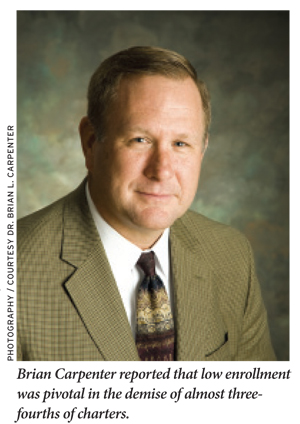 In hindsight, many were financially doomed from the outset. In examining the causes of charter school closures in the United States, former National Charter Schools Institute CEO Brian Carpenter reported in 2008 that low enrollment was pivotal in the demise of almost three-fourths of the 100 cases he studied. He advised school boards and authorizers to “strive for 300 students as the minimum desired enrollment for each school.” Yet most Ohio charters were and are below that threshold.
In hindsight, many were financially doomed from the outset. In examining the causes of charter school closures in the United States, former National Charter Schools Institute CEO Brian Carpenter reported in 2008 that low enrollment was pivotal in the demise of almost three-fourths of the 100 cases he studied. He advised school boards and authorizers to “strive for 300 students as the minimum desired enrollment for each school.” Yet most Ohio charters were and are below that threshold.
In studying charter schools nationally, Paul Hill of the University of Washington observed in 2008 that, while money doesn’t assure educational success, it’s needed to innovate successfully. “Due to the way money flows,” Hill wrote, “new [charter] schools face major competitive disadvantages. Only entities that believe they can run effective schools with less money than district-run schools, or are able to gain some forms of subsidy, either philanthropic contributions or donated labor, can hope to compete.” The exception seemed to be schools associated with large, deep-pocketed national school-management organizations such as Edison and National Heritage Academies.
Worried about the appearance, the legitimacy, and the politics of a charter sector dominated by big out-of-state firms, many of them for-profit, we thought it was especially important for Ohio to develop and sustain a healthy crop of mom-and-pop schools with bona fide community roots. In 2001, we launched the Education Resource Center (ERC), originally housed at the Dayton Area Chamber of Commerce and later within a private-scholarship organization named PACE.
The concept was straightforward. We would help independent charter schools acquire benefits of scale by concentrating some of their needs and corresponding services in a single place, particularly their business management and other “back office” functions. This should, we thought, lead to lower-cost services for individual schools while improving the quality of those services for all. This, we expected, would reinforce their capacity to compete, stay viable economically and, ultimately, deliver stronger academic achievement.
In 2003, ERC became a standalone nonprofit organization named Keys to Improving Dayton Schools, Inc. (k.i.d.s.). At the outset, Fordham’s Terry Ryan (as volunteer executive director) and Dayton businessman Doug Mangen ran the day-to-day operations of k.i.d.s., with help from Dayton-area philanthropists and business leaders, including the former CEO of Copeland Industries, Matt Diggs, who also worked to raise money for the new venture.
About 20 charters were then operating in Dayton. Mangen surveyed their needs and found that their most pressing challenges were improving financial management while boosting academic performance. It wasn’t just record keeping and poor test scores. Several schools admitted that they were on the verge of financial collapse. The situation was captured in a memo from Ryan to the k.i.d.s. board in late 2003. “Early hopes for their transformative potential,” he wrote, “are yielding to the realities of meager academic results, financial woes, leadership and governance difficulties, and political challenges. Local charter schools are largely consumed by issues of survival. As a result, they’re not pointing the way toward educational excellence.”
The Omega School of Excellence was first to sign on with k.i.d.s. Organized to serve 5th through 8th graders, Omega was modeled after the acclaimed Knowledge Is Power Program (KIPP) schools. Its graduates won scholarships to top local private high schools and to several of the country’s elite prep schools. But, like other one-off charters, Omega faced severe challenges on the business side. Co-founder Vanessa Ward (with her husband) admitted that she lacked those skills. “This is a business. It’s a start-up business. I think most persons who are in education don’t necessarily come with those gifts managing budgets and forecasting, insuring that you’re making the best decisions fiscally to allow a start-up business to survive.” The Wards and their colleagues on the Omega board craved quality financial-management support, and k.i.d.s. was set up to help provide it to worthy but needy schools like this one.
By mid-2005, k.i.d.s. employed six staffers and three consultants who not only had the school-finance knowledge and appropriate state certifications, but also possessed real expertise in navigating Ohio’s byzantine data-reporting systems. At the start of the 2005–06 school year, k.i.d.s. was serving 11 schools in four cities with a combined enrollment of about 1,860 students. The services generated about $400,000 in fees for “back office” services. Fordham also subsidized k.i.d.s. to the tune of about $150,000 a year.
The board of k.i.d.s., which included Fordham’s Finn as well as Ryan, widened its mandate, adding academic and operating activities (e.g., food service support) and new schools in other cities. Too many Ohio charter schools were struggling academically as well as financially. K.i.d.s. wanted to see if it could build a full-fledged, high-quality, local charter-management effort, something almost absent from Ohio at that time. This service might even include running whole-school operations.
By this point, the Omega school was facing serious academic as well as financial challenges. Its initial success had been driven largely by Vanessa Ward’s vision, energy, and commitment. In 2005, however, she had to shoulder more church responsibilities when her husband became seriously ill. School heads came and went. Enrollment dropped and the school faltered. Such challenges, we were coming to discover, plagued many one-off charter schools that depended too much on the vision and leadership of a single dynamic individual.
Gradually, Omega’s future prospects became more and more entwined with those of k.i.d.s., both because the school came to consume more of the nascent CMO’s (charter management organization) time and attention and because k.i.d.s.’ other revenues were drying up. A support grant from the Bill & Melinda Gates Foundation was spent. In 2006, Mangen spun off the one successful part of k.i.d.s.’ work—the financial services program—into his own new private business. Though Fordham and one or two other private donors did their best, the money just wasn’t there to keep k.i.d.s. afloat so long as its main client was the faltering, shrinking Omega School of Excellence.
When the Omega board authorized a formal resolution ceasing the school’s operations in June 2008, its demise dealt a mortal blow to k.i.d.s. and to our dream of creating a nonprofit school-management organization that could run successful schools across Dayton and southwestern Ohio.
Both organizations were also wounded by the national economic downturn that reduced Fordham’s endowment—and those of many others—by more than one-third. This fiscal misery made it far harder to raise money for a struggling school and a fledgling CMO that faced uncertain futures, even in flush times.
Human capital proved problematic, too. Finding and keeping great talent to work in Dayton’s charter sector was a nut that k.i.d.s. never cracked. And when it engaged the services of really capable individuals, they swiftly proved to be in great demand elsewhere.
Under these circumstances, we had to shelve our hopes for a Dayton-based CMO. There are, to be sure, several national charter outfits—e.g., Edison Learning, National Heritage Academies, Building Excellent Schools, KIPP—operating in Ohio and some of them do good work. But what this approach neglects, and what Ohio (and many other places) still needs, are mechanisms for strengthening the “mom-and-pop” schools like Omega that have deep roots in their communities yet lack the educational and management capacity necessary to sustain success.
Sobered and a bit battered, Fordham continues as an authorizer of Ohio charter schools—six of them today, with a seventh in the offing—and a vigorous participant in the state’s larger education-policy debates. We’re constantly exploring new options including, at this writing, possible merger with several other authorizers into a larger and, we hope, more stable and effective statewide sponsorship venture. Meanwhile, we’ve learned a lot about how much harder it is to walk the walk of education reform than simply to talk the talk, and about how the most robust of theories are apt to soften and melt in the furnace of actual experience. ?
This article appeared in the Fall 2010 issue of Education Next. Suggested citation format:
Finn, C.E., Ryan, T., and Lafferty, M.B. (2010). Authorizing Charters: Helping mom-and-pops in Ohio. Education Next, 10(4), 32-41.


